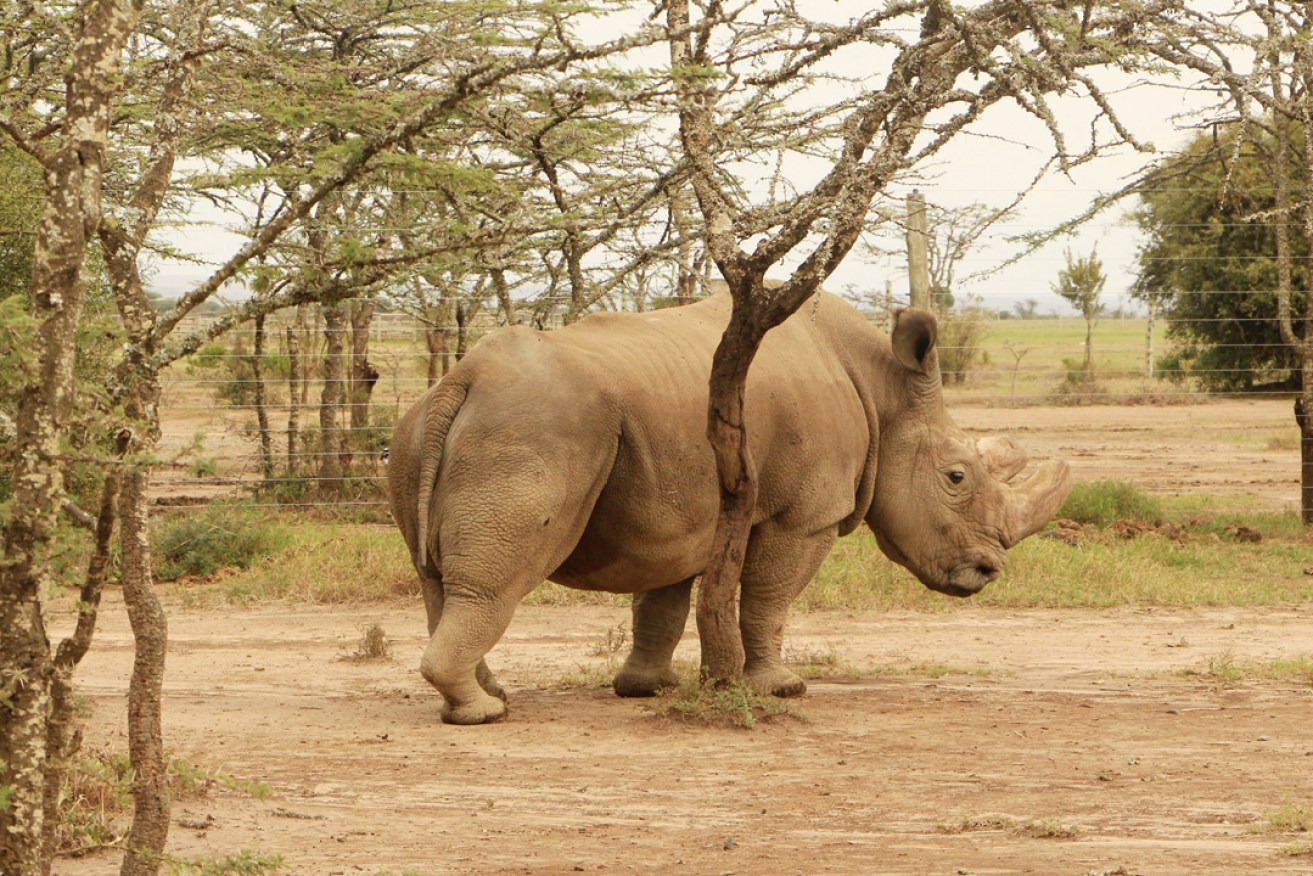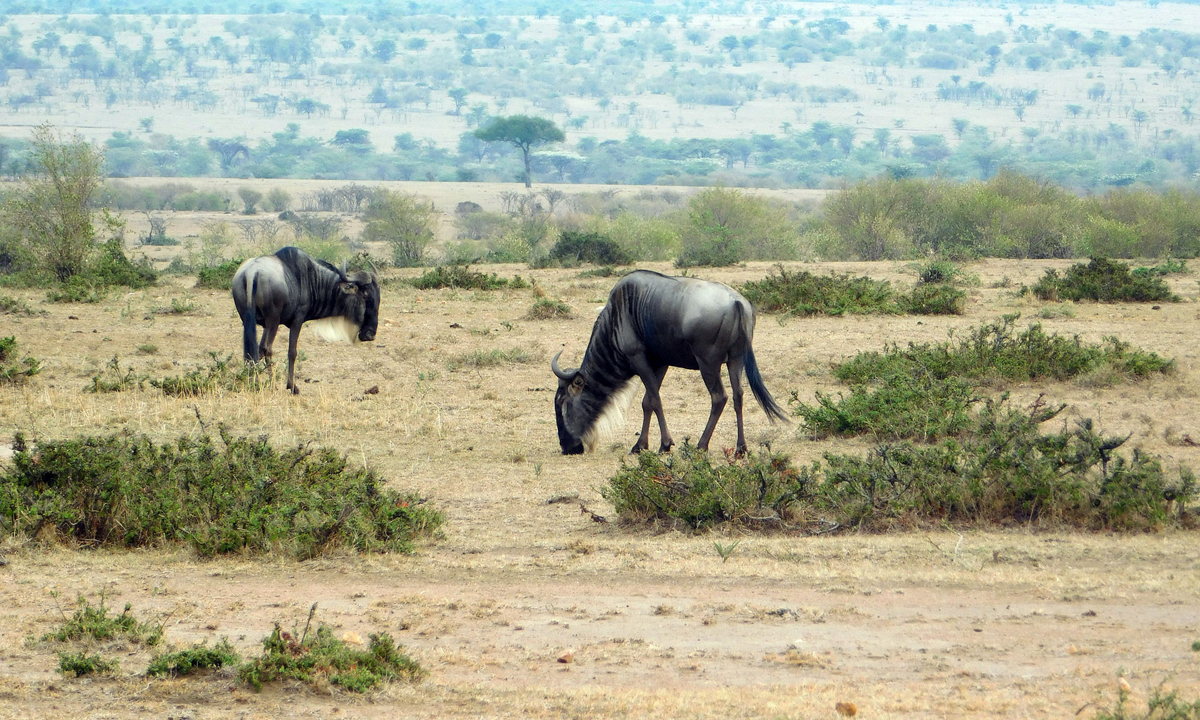Meet the world’s precious animals in Kenya
An African safari is all about timing and luck – and there’s nothing as exhilarating as an unexpected sighting.

Sudan is under constant guard to protect him from poachers. Photo: AAP
The four-wheel-drive has stopped and we’re all looking ahead at what can only be described as a massive lone male rhinoceros.
“Sudan, Sudan,” the keeper calls his name.
We’re all standing in shock. This is the world’s last male white northern rhino.
Sudan turns around and we’re immediately wrapped up in his marvel.
His giant horn – although half cut off to deter poachers – and leathery wrinkled head make you feel like this is the closest you’ll ever get to a dinosaur.
Sudan moves his head to get a look at us and we all stop breathing for a second. His thick skin and pillar-like legs resemble pure strength.
He soon chooses to ignore us, lowering his head to the ground in front of him with battered eyes, without realising just how precious he is.
Sudan is 45 years old. He was born in the wild in 1972 in Shame, southern Sudan, and in 1975 was captured and taken to Dvur Kralove Zoo in the Czech Republic.
Desperate to increase his chance of survival, authorities moved him to Kenya’s Ol Pejeta Conservancy, situated between the foothills of Mount Kenya and the Aberdares, in December 2009.
He is the last of his kind in the world and is under 24-hour armed guard to stop poachers.
Two remaining female white northern rhinos are close by, but both are incapable of natural reproduction.
The last hope for the white northern rhino species is artificially assisted reproduction, but given his age, Sudan’s days are numbered.
He isn’t bothered by our presence in his home; his time in captivity has made him somewhat tolerant of people.
We stare in awe at his heroic build and his lonely yet powerful presence. We can’t help but realise that no other person may get the same opportunity as us.
An African safari is all about opportunity, timing and pure luck. While you’re pretty much guaranteed to see a gazelle, giraffe and a lion, there are some animals that don’t make it so easy.

Wildebeests on the Maasai Mara. Photo: Stephanie Unna / flickr
Driving through the Maasai Mara in Kenya during migration season is exhilarating, not just because of the spectacle but because it means almost every other animal is out in the open.
As thousands of wildebeests run alongside our jeep, we see three cheetahs basking in the sun and five lions napping in the cool morning.
“You’ve done well for the day,” our guide Antony says.
Then we see a line of trucks, with one deep in the bush and every passenger gawking out the windows.
Antony says it can only be one animal – a leopard.
The elusive, solitary animals are tenaciously difficult to find. Antony tells us he only gets to see one once every few months.
We join the queue behind five trucks, crossing our fingers and toes that we’ll get the chance to spot the leopard too.
It’s finally our turn. We all immediately pounce up, camera in one hand, binoculars in the other.
Our eager eyes scan the surrounds, but we have no luck. Antony starts reversing the truck back when I see a spotted tail slither in the bushes.
I yell out and immediately, everyone in the truck pounces.
Without a second thought, Antony reverses back, puts his foot on the accelerator, mounts the car over a ditch and floors it to the other side of the river bank for a better vantage point.
He stops the car and we gasp in amazement.
I understand why these cats are so special.
They’re more gentle than lions and cheetahs, their fur more beautiful and their presence carries with it a gracefulness that I haven’t felt around any other animal.
Our excitement still hasn’t faded by the afternoon and with the African sunset as our backdrop, we enjoy a traditional sundowner and relish in our fortune.
Surely, we’ve experienced everything Kenya has to offer … and then we hear the roar of a lion in the distance.
Getting there: Etihad, Qatar Airways, Kenya Airways, Qantas, Emirates, Virgin Australia and China Southern all fly to Nairobi, Kenya.
Staying there: Gamewatchers Safaris offer a variety of safari holidays combining popular parks and wildlife conservancies with options to stay in accommodation ranging from luxury lodges to mobile tents. Each camp offers an intimate safari experience away from the crowds of tourists and minibuses. Prices are all inclusive of food and airport transfers. More details here.
Playing there: Ever wanted to kiss a giraffe? While you’re in Nairobi you can do exactly that at the Giraffe Centre – a non-profit organisation that educates school children on Kenya’s wildlife and environment as well as giving local and international visitors the chance to come really close to giraffes. For 500 Kenyan Shillings ($A6), you can stay as long as you like and feed the giraffes by hand or with your mouth. It’s open from 9am to 5pm seven days a week and is located 40 minutes from Nairobi’s city centre.
The David Sheldrick Wildlife Trust is an elephant orphanage located 15 minutes from the Giraffe Centre in Nairobi National Park. It’s open to the public from 11am to 12pm every day except for Christmas Day and during this time you can watch the orphans play together, bath and feed. Entrance is a minimum donation of 500 Kenyan Shillings.
-AAP




